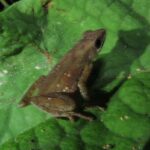Ischnocnema nigriventris: The Secretive Frog of the Brazilian Atlantic Forest#
Introduction#
Shrouded in mystery beneath lush canopies and thick rainforest foliage, a small amphibian lives quietly among the leaf litter—a creature hardly noticeable yet fascinatingly complex. Meet Ischnocnema nigriventris, the Black-bellied Robber Frog, an organism that whispers secrets about the diversity and health of Brazil’s precious Atlantic Forest ecosystems. Often overlooked due to its elusive nature, this tiny amphibian has gained increased attention from scientists and conservationists striving to understand its habits, behaviors, and vital role within its fragile habitat.
Though diminutive, Ischnocnema nigriventris challenges our assumptions of frogs being passive creatures. Armed solely with subtle camouflage and remarkable adaptability, it masters survival within a dense environment fraught with hidden dangers. By exploring its intriguing life and the threats it faces today, we unravel a story unparalleled in drama, ecological significance, and urgent conservation priority.
Taxonomy and Classification#
Ischnocnema nigriventris, scientifically categorized under the family Brachycephalidae, occupies a unique branch within a diverse assemblage of frogs known for their direct-development lifecycle. Within its genus Ischnocnema, the Black-bellied Robber Frog appears as one among numerous subtly distinct frog species typical to the Neotropical region.
The differentiation between individual Ischnocnema species can be subtle yet significant, characterized largely by morphological traits and genetic data. Similarities and interspecies relationships continually undergoing scientific reassessment highlight the ongoing richness of amphibian systematics research in Brazil’s forests. As scientists better understand these familial connections, we begin to appreciate the hidden genetic diversity nestled beneath forest floors.
Natural Habitat#
Geographic Range and Distribution#
The Black-bellied Robber Frog inhabits Brazil’s Atlantic Forest biome, a globally recognized biodiversity hotspot with notably high levels of species endemism. Specifically, populations of Ischnocnema nigriventris are mostly documented in southeastern Brazil—regions including the states of São Paulo and Rio de Janeiro. Their distribution is patchy and localized, generally restricted to areas with intact primary and secondary rainforest habitat.
Preferred Microhabitats#
Unlike aquatic-dependent frogs, Ischnocnema nigriventris is terrestrial, choosing a moist, leaf-litter-rich environment as its primary domain. These frogs inhabit shaded understory regions characterized by high humidity, abundant plant life, fallen leaves, and logs. Here, amid decomposing organic matter and damp earth, they skillfully dodge predators and capture prey, thriving in a niche delicately balanced between shelter and vulnerability.
This careful positioning within the forest layers offers effective camouflage and abundant insect prey, underscoring a fine-tuned ecological specialization honed through evolutionary adaptation.
Physical Characteristics#
A small-sized frog, adult Ischnocnema nigriventris reach lengths averaging only about 20–30 millimeters. Despite their diminutive stature, they carry a blend of subtle yet distinctive traits. The coloration of this species ranges widely—individuals often exhibit shades of brown, tan, or olive tones, melded seamlessly with darker mottling, granting remarkably effective camouflage among forest debris.
The defining physical trait, however, remains their darkly pigmented belly, giving them their common name. This black ventral surface starkly contrasts with their cryptically colored dorsal region. Scientists hypothesize this dark belly may serve to deter potential predators by signaling unpalatability or simply prevent predation by blending into dark forest soil when viewed from below.
Their eyes, relatively large for their size, feature horizontally elliptical pupils adapted for low-light conditions, enhancing their ability to hunt insect prey effectively during dim twilight hours. Small, agile legs afford them rapid movements, helping them evade danger swiftly and efficiently amidst the forest leaf litter.
Behavior and Life Cycle#
Elusive Survival Tactics#
Primarily nocturnal, Ischnocnema nigriventris spends the daylight hours concealed beneath leaf debris or hidden within moist crevices. This reclusive behavior is paramount to survival, reducing vulnerability to daytime predators like birds, snakes, and mammals.
With nightfall, however, the forest floor comes vividly alive as these frogs venture out to actively forage. Their diet predominantly comprises small invertebrates, including ants, beetles, mites, and springtails. Equipped with agile tongues and precision leaps, their nocturnal hunting sessions represent miniature dance performances, carefully orchestrated maneuvers maintaining their sustenance and survival.
An Intriguing “Direct” Development#
A fascinating reproductive oddity of Ischnocnema nigriventris is its direct development lifecycle—skipping entirely the tadpole stage. Unlike most frogs whose eggs develop in water before transforming into land-dwelling juveniles, these frogs lay eggs beneath damp leaves on the forest floor. Moisture retention beneath leaf litter provides an ideal incubation site for their jelly-like egg clusters, offering protection from desiccation, predation, and environmental fluctuations.
Direct development allows these tiny froglets to emerge from eggs remarkably similar to their adult counterparts, prepared immediately to dwell and hunt in forest ecosystems. This trait reflects a crucial adaptation to terrestrial habitats lacking steady water resources common in drier or variable environments of the Atlantic rainforest.
Ecological Role#
As a predator of small invertebrates within leaf litter, Ischnocnema nigriventris contributes significantly to the ecological balance. By controlling insect populations and serving simultaneously as a prey resource for various animals, these frogs form a pivotal link within rainforest food webs.
Furthermore, amphibians at large—particularly sensitive terrestrial species like Ischnocnema nigriventris—often serve as indicator species, barometers gauging ecosystem health. Their disappearance may indicate instabilities or ecological disturbances, making them invaluable biological sentinels in conserving Brazil’s diverse rainforest habitats.
Threats and Conservation Status#
Sadly, this seemingly resilient species faces mounting threats. Principal among these threats is habitat loss due primarily to agriculture expansion, forestry operations, urbanization, and extensive fragmentation of the Atlantic Forest ecosystems. Additionally, climate change-driven shifts in weather patterns and rainfall distribution pose considerable long-term risks to their survival.
The International Union for Conservation of Nature (IUCN) currently classifies Ischnocnema nigriventris as a species of “Least Concern,” yet conservationists caution that declining habitat integrity paints a troubled future. Localized populations may be significantly threatened without targeted conservation actions and ongoing monitoring initiatives. Protecting primary rainforest areas and restoring fragmented corridors emerges as crucial to this species’ continued existence.
Cultural and Scientific Significance#
Although not broadly celebrated in Brazilian folklore, frogs like the Black-bellied Robber Frog hold ecological and cultural significance as symbols of healthy forests and biodiversity. Scientifically, they offer invaluable insights into evolutionary processes, ecological adaptations, and even potential biomedical applications. Amphibian skin secretions worldwide have guided researchers toward antibiotic properties and theoretical medical applications, suggesting undiscovered potential within many poorly studied species, including Ischnocnema nigriventris.
Conclusion#
Though rarely seen by human eyes, Ischnocnema nigriventris plays a critical role within its native Brazilian Atlantic Forest. Each frog embodies millions of years of evolution and adaptation, silently maintaining balance within the ecological tapestry. Understanding and protecting species like the Black-bellied Robber Frog serve more than biodiversity—it secures the broader health of ecosystems upon which humans equally depend.
As forests shrink and climate dynamics change, protecting these humble, vital creatures has never been more critical. For every conservation advocate, nature enthusiast, student, or curious wanderer, embracing the story of Ischnocnema nigriventris represents a step closer to safeguarding and celebrating our planet’s extraordinary biological heritage.







